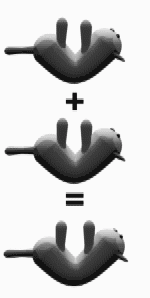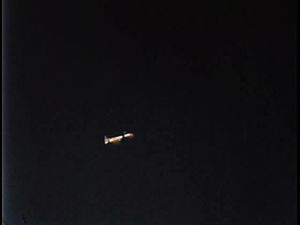Cat righting reflex

The cat righting reflex is a cat's innate ability to orient itself as it falls in order to land on its feet. The righting reflex begins to appear at 3–4 weeks of age, and is perfected at 6–9 weeks.[1] Cats are able to do this because they have an unusually flexible backbone and no functional clavicle (collarbone). The tail seems to help but cats without a tail also have this ability, since a cat mostly turns by moving its legs and twisting its spine in a certain sequence.[2]
Technique[]

After determining down from up visually or with their vestibular apparatus (in the inner ear), cats manage to twist themselves to face downward without changing their net angular momentum. They are able to accomplish this with these key steps:
- Bend in the middle so that the front half of their body rotates about a different axis from the rear half.
- Tuck their front legs in to reduce the moment of inertia of the front half of their body and extend their rear legs to increase the moment of inertia of the rear half of their body so that they can rotate their front by as much as 90° while the rear half rotates in the opposite direction as little as 10°.
- Extend their front legs and tuck their rear legs so that they can rotate their rear half further while their front half rotates in the opposite direction less.
Depending on the cat's flexibility and initial angular momentum, if any, the cat may need to perform steps two and three repeatedly to complete a full 180° rotation.[3][4][5]
Terminal velocity[]
In addition to the righting reflex, cats have other features that reduce damage from a fall. Their small size, light bone structure, and thick fur decrease their terminal velocity. While falling, a cat spreads out its body to increase drag.[6] An average-sized cat with its limbs extended achieves a terminal velocity of about 60 mph (97 km/h), while an average-sized man reaches a terminal velocity of about 120 mph (190 km/h).[7] A 2003 study of feline high-rise syndrome found that cats 'orient [their] limbs horizontally after achieving maximum velocity so that the impact is more evenly distributed throughout the body'.[8]: 311
Injury[]
With their righting reflex, cats often land uninjured. However, this is not always the case, since cats can still break bones or die from extreme falls. In a 1987 study, published in the Journal of the American Veterinary Medical Association, of 132 cats that were brought into the New York Animal Medical Center after having fallen from buildings, it was found that the injuries per cat increased depending on the height fallen up to seven stories, but decreased above seven stories. One cat survived a fall of 46 stories and landed with no injuries at all.[9] The study authors speculated that after falling five stories the cats reached terminal velocity and thereafter relaxed and spread their bodies to increase drag. However, critics of the study pointed out a survivorship bias in that instantly fatal falls were not included (as an already dead cat would not be taken to the vet), questioning the authors' conclusion that the injury rate declined for higher falls.[9] A 2003 study of 119 cats concluded that "Falls from the seventh or higher stories, are associated with more severe injuries and with a higher incidence of thoracic trauma."[10]
See also[]
- Falling cat problem – the mathematical problem of explaining the physics of the cat righting reflex
- High-rise syndrome
- Buttered cat paradox – a humorous combination of two proverbs
References[]
- ^ Sechzera, Jeri A.; Folsteina, Susan E.; Geigera, Eric H.; Mervisa, Ronald F.; Meehana, Suzanne M. (December 1984). "Development and maturation of postural reflexes in normal kittens". Experimental Neurology. 86 (3): 493–505. doi:10.1016/0014-4886(84)90084-0. PMID 6499990.
- ^ Nguyen, Huy D. "How does a Cat always land on its feet?". Georgia Institute of Technology, School of Medical Engineering. Archived from the original on 2001-04-10. Retrieved 2007-05-15.
- ^ Fink, Hardy (February 1997). "An insight into the Biomechanics of Twisting". Technique. USA Gymnastics. 17 (2). Archived from the original on 1998-05-28. Retrieved 2007-12-26.
- ^ Calle, Carlos I. (2001-10-10). Superstrings and Other Things: A Guide to Physics. CRC Press. pp. 106, 107. ISBN 9780750307079. Retrieved 2008-06-04.
- ^ Kane, Thomas; Scher, M. P. (1969). "A dynamical explanation of the falling cat phenomenon". International Journal of Solids and Structures. 5 (7): 663–670. doi:10.1016/0020-7683(69)90086-9.
- ^ Hutchinson, J.R. (11 January 1996). "Vertebrate Flight: Gliding and Parachuting". University of California Museum of Paleontology. Retrieved 22 December 2016.
- ^ Nasaw, D. (25 March 2012). "Who, What, Why: How do cats survive falls from great heights?". BBC News Online. Retrieved 22 December 2016.
- ^ Vnuk, D.; Pirkić, B.; et al. (18 June 2003). "Feline high-rise syndrome: 119 cases (1998–2001)". J Feline Med Surg. 6 (5): 305–12. doi:10.1016/j.jfms.2003.07.001. PMID 15363762.
- ^ a b Adams, Cecil (1996-07-19). "The Straight Dope: Do cats always land unharmed on their feet, no matter how far they fall?". The Straight Dope. Archived from the original on 2000-08-15. Retrieved 2008-06-04.
- ^ Vnuk, D.; Pirkić, B.; Matičić, D.; Radišić, B.; Stejskal, M.; Babić, T.; Kreszinger, M.; Lemo, N. (1 October 2004). "Feline high-rise syndrome: 119 cases (1998–2001)". Journal of Feline Medicine and Surgery. 6 (5): 305–312. doi:10.1016/j.jfms.2003.07.001. PMID 15363762.
Further reading[]
- Arabyan, A.; Tsai, D. (1998). "A distributed control model for the air-righting reflex of a cat". Biol. Cybern. 79 (5): 393–401. doi:10.1007/s004220050488. PMID 9851020.
- Diamond, J. (1988). "Why cats have nine lives". Nature. 332 (6165): 586–587. Bibcode:1988Natur.332..586D. doi:10.1038/332586a0. PMID 3357516.
- ; Kalli-Laouri, J.; Schwartze, P. (1990). "The postnatal development of the air-righting reaction in albino rats. Quantitative analysis of normal development and the effect of preventing neck-torso and torso-pelvis rotations". Behavioural Brain Research. 37 (1): 37–44. doi:10.1016/0166-4328(90)90070-U. PMID 2310493.
- Laouris, Y.; Kalli-Laouri, J.; Schwartze, P. (1990). "The influence of altered head, thorax and pelvis mass on the postnatal development of the air righting reaction in albino rats". Behav. Brain Res. 38 (2): 185–190. doi:10.1016/0166-4328(90)90016-8. PMID 2363837.
External links[]
- The surprisingly complicated physics of why cats always land on their feet
- Why cats land on their feet
- National Geographic video on the cat righting reflex
- The miracle of the falling cat
- How do cats always land on their feet? Super slow motion video of the African caracal.
- Slow Motion Flipping Cat Physics
- Cat behavior
- Reflexes
